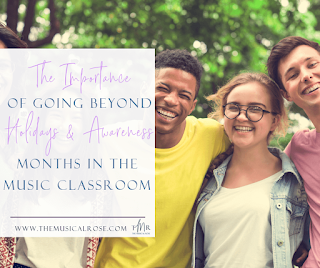The last "favorites" post for 2019- crazy! Of course December is always a fun-filled month so it's hard to choose, but here are some highlights from the past month, told through some of my Instagram photos. Come follow along for some inspiration, and share your own favorites in the comments!
1. Sing Along Updates
I wrote an entire blog post about this but I was so happy with the updates I made to my whole-school holiday sing-along this year. I added in songs for Eid and Lunar New Year, and they were both big hits with the students. This year the sing-along almost didn't happen at all because of snow, but thankfully we were able to reschedule it, and I'm so glad we did in spite of the craziness of running around to make it happen.
2. Advent Activities
Of course the advent activities I do with my daughters each day in December are always one of the highlights of the month for me. I made this little advent calendar back in 2014 when my daughters were almost 3, and we've been doing it every year since then. The best part now is that my girls remember and look forward to it when December is approaching! It was so much fun and so little work, honestly, which is the best part- it just keeps me from spiraling out of control thinking about all the stuff I have to do at work and helps me stay focused on being with my family when I'm at home.
3. Christmas Planner Spreads
I always love playing around with planner decorating- it's my way of keeping my scrapbooking and crafting hobby going- but it's especially fun in December because it's one of the few holidays I really enjoy acknowledging in thematic spreads. A lot of the sticker books I have collected over the years have specifically Christmas- themed stickers in them so I spend the rest of the year basically waiting for the chance to use them! You can read about how I decorate my planner in a way that still keeps my pages super functional in this post (with accompanying video):
4. Music Education Blog Posts
Here are some of my favorite posts I found this month! I share these weekly over on my Facebook page. Click the images to read each post:
I hope you all had a wonderful December as well and are looking forward to a fantastic 2020- can you believe it?!? Here we go to another new year!
1. Sing Along Updates
I wrote an entire blog post about this but I was so happy with the updates I made to my whole-school holiday sing-along this year. I added in songs for Eid and Lunar New Year, and they were both big hits with the students. This year the sing-along almost didn't happen at all because of snow, but thankfully we were able to reschedule it, and I'm so glad we did in spite of the craziness of running around to make it happen.
2. Advent Activities
Of course the advent activities I do with my daughters each day in December are always one of the highlights of the month for me. I made this little advent calendar back in 2014 when my daughters were almost 3, and we've been doing it every year since then. The best part now is that my girls remember and look forward to it when December is approaching! It was so much fun and so little work, honestly, which is the best part- it just keeps me from spiraling out of control thinking about all the stuff I have to do at work and helps me stay focused on being with my family when I'm at home.
3. Christmas Planner Spreads
I always love playing around with planner decorating- it's my way of keeping my scrapbooking and crafting hobby going- but it's especially fun in December because it's one of the few holidays I really enjoy acknowledging in thematic spreads. A lot of the sticker books I have collected over the years have specifically Christmas- themed stickers in them so I spend the rest of the year basically waiting for the chance to use them! You can read about how I decorate my planner in a way that still keeps my pages super functional in this post (with accompanying video):
4. Music Education Blog Posts
Here are some of my favorite posts I found this month! I share these weekly over on my Facebook page. Click the images to read each post:
I hope you all had a wonderful December as well and are looking forward to a fantastic 2020- can you believe it?!? Here we go to another new year!


























































